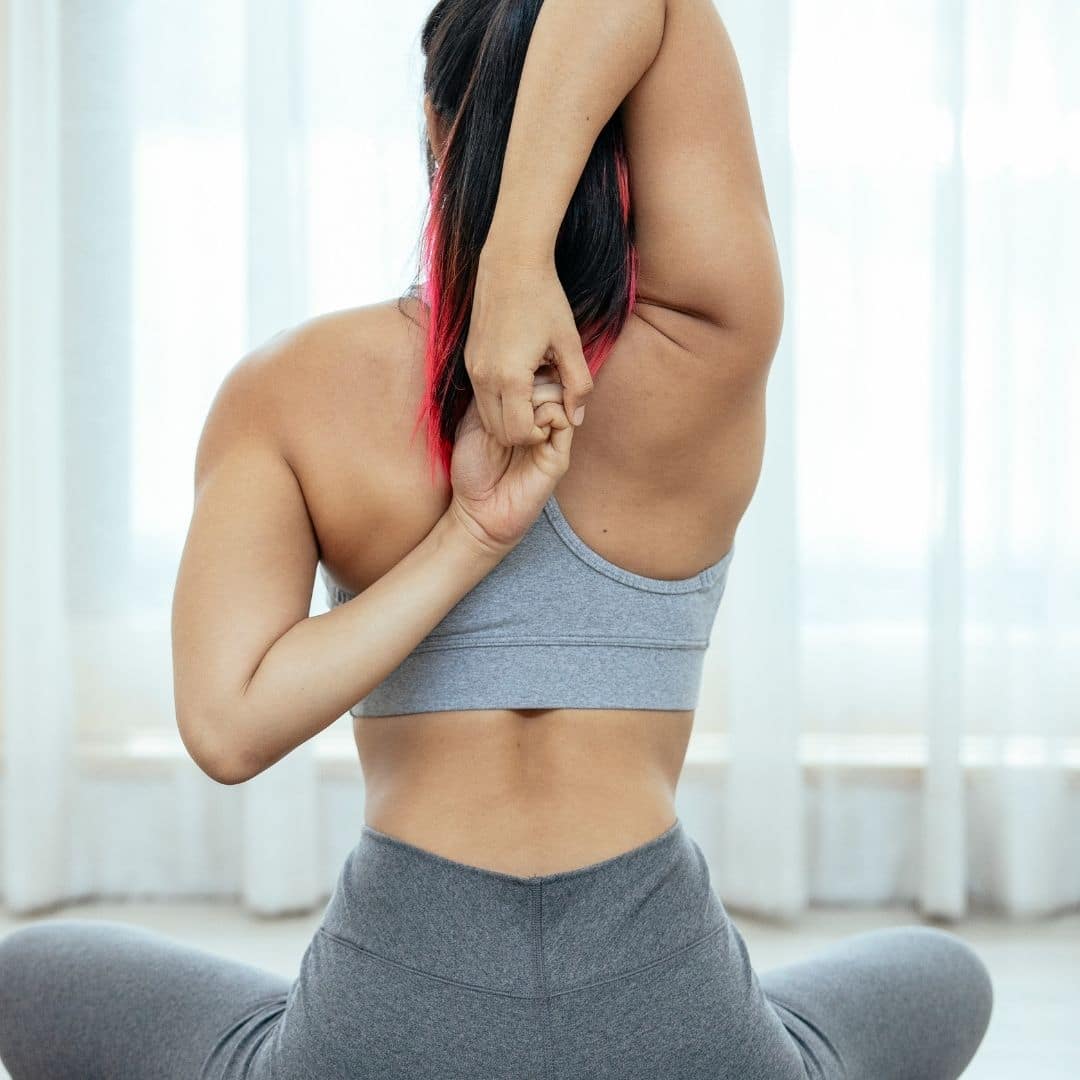Good posture is your body’s way of reducing stress on your muscles and ligaments. It allows your body to function at its best and can help to prevent pain and injury.
In this article, we will discuss how good posture is critical for physical and mental health while suggesting targeted exercises to improve posture, boost energy, and improve overall well-being.
Impact on Health and Confidence
Physically, good posture can help to improve your breathing, circulation, and digestion. It can also help to reduce pain and tension in your muscles and joints. Good posture can also help to improve your balance and coordination, which can reduce your risk of falls and other injuries.
Mentally, good posture can help to improve your self-confidence and self-esteem. It can also help you to feel more alert and energized. Studies show that good posture has also been shown to improve cognitive function and performance.
Understanding Posture
Many factors can contribute to poor posture, including weak back muscles, a sedentary lifestyle, repetitive movements, and injury. If you spend a lot of time sitting and doing repetitive movements your muscles can become stressed or weakened and you are more likely to develop poor posture as well as core and shoulder stability.
Postural Elements
Good posture involves proper spinal alignment, shoulder positioning, and pelvic tilt.
- Spine Alignment: The spine should be in a neutral position, with a slight natural curve in the lower back. This curve helps to absorb shock and support the weight of your upper body and rounded shoulders.
- Shoulder Positioning: Your shoulders should be relaxed and hanging down at your sides. Your shoulder blades should be retracted (pulled back) and slightly downward.
- Pelvic Tilt: Your pelvis should be in a neutral position, with a slight anterior tilt (forward tilt). This tilt helps to keep your spine in alignment and your abdominal muscles engaged.
Common Postural Issues
Common issues like forward head, kyphosis, and lordosis deviate from ideal posture and can lead to pain and health issues if proper posture is not addressed.
- Forward Head Posture: Forward head posture is a common problem in which the head is tilted forward, bringing the chin towards the chest. This can lead to neck pain, headaches, and muscle tension in the shoulders and back.
- Kyphosis: Kyphosis, also known as a hunchback, is a condition in which the upper back is excessively curved. This can lead to pain in the back muscles, fatigue, and difficulty breathing.
- Lordosis: Lordosis, also known as swayback, is a condition in which the lower back is excessively curved. This can lead to back pain, muscle tension, and difficulty maintaining balance.
Strengthening Core Muscles

The core is a group of muscles that includes the abdomen, back, and pelvis. Core muscles are responsible for stabilizing the spine and pelvis, and for generating power for movement. A strong core is essential for good posture, balance, and coordination.
These types of exercises to improve posture are important for preventing back pain and injuries, and for improving athletic performance
Exercises for Core Strengthening
Many different exercises can be used to strengthen the core. You can do these exercises 2-3 times per week to see improvement in your core strength. Not to mention that you have to understand the best frequency and duration when going to the gym. Some of the most common and effective back-strengthening posture exercises that RxFit recommends are:
Planks
Planks are great posture exercises for strengthening the core muscles. To do a plank, start in a push-up position with your forearms on the ground. Make sure that your body forms a straight line from your head to your heels. Hold the position for 30-60 seconds, or as long as you can maintain good form.
Russian Twists
Russian twists are great posture exercises for strengthening the core muscles. To do a properly executed Russian twist, sit on the ground with your knees and elbows bent, and your feet flat. Hold a weight in front of you with both hands. Rotate your torso to one side, then back to the center, and then to the other side. Repeat for 10-15 repetitions per side.
Leg Raises
Leg raises are good posture exercises for strengthening the lower abdominal muscles. To do a leg raise, lie on your back with your legs extended in the air. Slowly raise your legs towards the ceiling until they are perpendicular to the ground. Hold the position for 1-2 seconds, then slowly lower your legs back down to the ground. Repeat for 10-15 repetitions.
Enhancing Spinal Flexibility
Spinal flexibility is the ability to move the spine through its full range of motion. It is important for maintaining good posture, reducing back pain, and improving athletic performance.
A flexible spine allows the body to move more efficiently and effectively. It also helps to absorb shock and protect the spine from injury and bad posture.
Exercises for Spinal Flexibility
There are many different exercises to improve posture that can be used to improve spinal flexibility. These exercises can be done daily to improve spinal flexibility. It’s important to ease into these exercises. Some of the most common and effective exercises that Rx-Fit recommends are:
Cat-Cow Stretch
The cat-cow stretch is a gentle stretch that helps to improve flexibility in the neck, upper back muscles, and shoulders.
Start on your hands and knees with your back flat to do a cat-cow stretch. As you inhale, arch your back and look up toward the ceiling. As you exhale, round your back and tuck your chin to your chest. Repeat for 10-15 repetitions.
Child’s Pose
Child’s pose is a relaxing stretch that helps to lengthen the spine and hamstrings.
To do the child’s pose, kneel on the ground with your knees hip-width apart. Sit back on your heels and fold forward, resting your forehead on the ground. Extend your arms out in front of you. Hold for 10-30 seconds.
Spinal Twist
The spinal twist is a stretch that helps to improve flexibility in the spine and hips.
To do a proper spinal twist, lie on your back with your knees bent and your feet flat. Cross your right knee and leg over your left leg and rest the right foot on the outside of the left knee. Gently turn your head and neck to the right. Hold for 10-30 seconds, then repeat on the other side.
Improving Shoulder Alignment
Proper shoulder alignment is important. When the shoulders are aligned correctly, the muscles around the shoulder blades can work together more efficiently, which can help to improve balance, coordination, and range of motion.
Exercises for Shoulder Alignment
Several exercises can help to improve shoulder alignment. These exercises to improve posture can be done daily to improve shoulder alignment. Some of the most common and effective exercises that we at RxFit recommend are:
Shoulder Blade Squeezes
Shoulder blade squeezes are a simple exercise that can help to strengthen the muscles around the shoulder blades.
To do a shoulder blade squeeze, stand with your feet shoulder-width apart and your arms relaxed at your sides. Slowly squeeze your shoulder blades together, then relax. Repeat squeezing shoulder blades together for 10-15 repetitions.
Wall Angels
Wall Angels are a great exercise for strengthening the rotator cuff and other muscles around the neck muscles and shoulders.
To do a wall angel, stand with your back against a wall and your feet shoulder-width apart. Raise your arms out to the sides so that they are parallel to the floor. Slowly slide your arms up the wall until they are overhead, keeping your back flat against the wall. Slowly slide your arms back down the wall to the starting position. Repeat for 10-15 repetitions.
Y-Raises
Y-raises are a good exercise for strengthening the muscles in the upper back and shoulders.
To do a Y-raise, lie on your stomach with your arms extended straight overhead. Slowly raise your arms in a Y-shape, keeping your elbows straight. Hold this extension for 1-2 seconds, then slowly lower your arms back down to the starting position. Repeat for 10-15 repetitions.
However, if you have any pain or discomfort, RxFit recommends that you stop the exercise and consult with a doctor or physical therapist.
Achieving Pelvic Stability
Pelvic stability is the ability of the pelvis to maintain its neutral position during movement and weight bearing. This means that the pelvis should be neither too tilted forward (anterior tilt) nor too tilted in the opposite direction or backward (posterior tilt).
Good pelvic stability is important for good posture. When the pelvis is stable, it can support the spine in its natural alignment. Workouts that improve hip mobility, help to reduce muscle strain and pain and improve balance and coordination.
Exercises for Pelvic Stability
There are several exercises to improve posture that can help to improve pelvic stability. These exercises can be done daily to improve pelvic stability. Some of the most common and effective exercises to improve posture that we recommend are:
Hip Bridges
Hip bridges are a great exercise for strengthening the core muscles, including the pelvic floor muscles.
To do a proper hip bridge, lie on your back with your knees bent and your feet flat. Place your arms at your sides. Raise your hips off the ground until your body forms a straight line from your shoulders to your knees. Hold for 1-2 seconds, then slowly lower your hips back down to the starting position. Repeat for 10-15 repetitions.
Clamshells
Clamshells are a good exercise for strengthening the gluteal muscles and hip abductors even without the use of machines.
To do a properly executed clamshell, lie on your side with your knees bent and your feet stacked on top of each other. Place your left hand on your hip and the other hand on the ground in front of you for support. Raise your top knee towards the ceiling, keeping your hips stacked and your core engaged. Hold this for 1-2 seconds, then slowly lower your knee back down to the starting position. Repeat for 10-15 repetitions on each side.
Dead Bugs
Dead bugs are a challenging exercise that works the core muscles, including the pelvic floor muscles.
To do a dead bug, lie on your back with your arms extended straight overhead and your legs extended straight in the air. Slowly lower your right arm and left leg down towards the ground, while keeping your core engaged. Hold for 1-2 seconds, then slowly return to the starting position. Repeat on the other side. Continue alternating sides for 10-15 repetitions.
Incorporating Ergonomics

Workspace ergonomics is the practice of designing the workplace to fit the worker, rather than the other way around. By incorporating ergonomics into your workspace and following these daily habits, you can reduce fatigue, discomfort, and the risk of injury.
Daily Habits for Better Posture
Here are some daily habits that RxFit suggests can help you improve your posture through ergonomics:
Sitting Posture Tips
- Sit with your back straight against your chair. Avoid hunching forward or slouching.
- Keep your shoulders relaxed and down.
- Keep your feet flat on the floor.
- If your feet don’t reach the floor, use a footrest.
- Avoid crossing your legs. This can put stress on your spine and hips.
Standing Posture Tips
- Stand up straight with your feet shoulder-width apart.
- Tuck your chin slightly and keep your shoulders relaxed.
- Distribute your weight evenly on both feet.
- Avoid locking your knees.
- If you need to stand for long periods, shift your weight from one foot to the other and take breaks to move around.
Progressive Posture Improvement Plan
To create a personalized posture improvement plan, you need to assess your current posture and identify the areas that need improvement. You can do this by asking a friend or family member to take a picture of you from the side or by standing in front of a mirror and checking your alignment.
Once you have a good understanding of your posture, you can start to develop a plan to improve your upright posture.
Setting Realistic Goals
When setting goals for your posture improvement plan, Rxfit would like to emphasize the importance of being realistic. Don’t expect to see perfect posture overnight. It takes time and effort to change your habitual bad posture and patterns. Start by setting small, achievable goals. Once you have reached that goal, you can gradually increase the time you spend with good posture.
It is also important to be patient. It takes time to see and feel the results of your posture improvement plan. Don’t get discouraged if you don’t see immediate results. Just keep practicing to maintain good posture, and doing your exercises, and you will eventually see a difference.
Need A Personal Trainer To Help You Set Realistic Goals? Contact A Certified RxFit Trainer Today!
Summary
Good posture is important for overall health and well-being. It can help to reduce pain, improve balance and coordination, and increase energy levels due to poor posture. There are many things that you can do to improve your posture, such as strengthening your core muscles, improving your flexibility, and being mindful of your posture throughout the day.
If you are concerned about your posture, or if you are experiencing pain or discomfort a personalized plan can improve it.
RxFit is here to facilitate this need and will work with you to properly execute these exercises to improve posture.
Take That First Step And Get Started With A Free RxFit Assessment Today!
